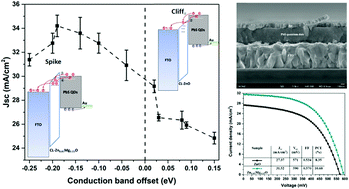当前位置:
X-MOL 学术
›
Nanoscale Horiz.
›
论文详情
Our official English website, www.x-mol.net, welcomes your
feedback! (Note: you will need to create a separate account there.)
Understanding charge transfer and recombination by interface engineering for improving the efficiency of PbS quantum dot solar cells†
Nanoscale Horizons ( IF 8.0 ) Pub Date : 2018-03-26 00:00:00 , DOI: 10.1039/c8nh00030a Chao Ding 1, 2, 3, 4, 5 , Yaohong Zhang 1, 2, 3, 4 , Feng Liu 1, 2, 3, 4 , Yukiko Kitabatake 4, 6, 7, 8 , Shuzi Hayase 4, 9, 10, 11, 12 , Taro Toyoda 1, 2, 3, 4, 12 , Ruixiang Wang 13, 14, 15, 16 , Kenji Yoshino 4, 12, 17, 18, 19 , Takashi Minemoto 4, 12, 17, 18, 20 , Qing Shen 1, 2, 3, 4, 12
Nanoscale Horizons ( IF 8.0 ) Pub Date : 2018-03-26 00:00:00 , DOI: 10.1039/c8nh00030a Chao Ding 1, 2, 3, 4, 5 , Yaohong Zhang 1, 2, 3, 4 , Feng Liu 1, 2, 3, 4 , Yukiko Kitabatake 4, 6, 7, 8 , Shuzi Hayase 4, 9, 10, 11, 12 , Taro Toyoda 1, 2, 3, 4, 12 , Ruixiang Wang 13, 14, 15, 16 , Kenji Yoshino 4, 12, 17, 18, 19 , Takashi Minemoto 4, 12, 17, 18, 20 , Qing Shen 1, 2, 3, 4, 12
Affiliation

|
In quantum dot heterojunction solar cells (QDHSCs), the QD active layer absorbs sunlight and then transfers the photogenerated electrons to an electron-transport layer (ETL). It is generally believed that the conduction band minimum (CBM) of the ETL should be lower than that of the QDs to enable efficient charge transfer from the QDs to the collection electrode (here, FTO) through the ETL. However, by employing Mg-doped ZnO (Zn1−xMgxO) as a model ETL in PbS QDHSCs, we found that an ETL with a lower CBM is not necessary to realize efficient charge transfer in QDHSCs. The existence of shallow defect states in the Zn1−xMgxO ETL can serve as additional charge-transfer pathways. In addition, the conduction band offset (CBO) between the ETL and the QD absorber has been, for the first time, revealed to significantly affect interfacial recombination in QDHSCs. We demonstrate that a spike in the band structure at the ETL/QD interface is useful for suppressing interfacial recombination and improving the open-circuit voltage. By varying the Mg doping level in ZnO, we were able to tune the CBM, defect distribution and carrier concentration in the ETL, which play key roles in charge transfer and recombination and therefore the device performance. PbS QDHSCs based on the optimized Zn1−xMgxO ETL exhibited a high power conversion efficiency of 10.6%. Our findings provide important guidance for enhancing the photovoltaic performance of QD-based solar cells.
中文翻译:

通过界面工程了解电荷转移和重组,以提高PbS量子点太阳能电池的效率†
在量子点异质结太阳能电池(QDHSC)中,QD活性层吸收阳光,然后将光生电子转移到电子传输层(ETL)。通常认为,ETL的导带最小值(CBM)应该低于QD的导带最小值,以实现通过ETL从QD到收集电极(此处为FTO)的有效电荷转移。但是,通过在PbS QDHSC中采用掺Mg的ZnO(Zn 1- x Mg x O)作为模型ETL,我们发现具有较低CBM的ETL并不需要在QDHSC中实现有效的电荷转移。Zn 1− x Mg x中存在浅缺陷态O ETL可以充当其他电荷转移途径。此外,首次揭示了ETL和QD吸收剂之间的导带偏移(CBO)对QDHSC中的界面重组产生了重大影响。我们证明,在ETL / QD接口处的能带结构中的尖峰对于抑制界面复合和改善开路电压很有用。通过改变ZnO中的Mg掺杂水平,我们能够调整ETL中的CBM,缺陷分布和载流子浓度,它们在电荷转移和复合以及器件性能中起着关键作用。基于优化的Zn 1- x Mg x的PbS QDHSCO ETL表现出10.6%的高功率转换效率。我们的发现为增强基于量子点的太阳能电池的光伏性能提供了重要的指导。
更新日期:2018-03-26
中文翻译:

通过界面工程了解电荷转移和重组,以提高PbS量子点太阳能电池的效率†
在量子点异质结太阳能电池(QDHSC)中,QD活性层吸收阳光,然后将光生电子转移到电子传输层(ETL)。通常认为,ETL的导带最小值(CBM)应该低于QD的导带最小值,以实现通过ETL从QD到收集电极(此处为FTO)的有效电荷转移。但是,通过在PbS QDHSC中采用掺Mg的ZnO(Zn 1- x Mg x O)作为模型ETL,我们发现具有较低CBM的ETL并不需要在QDHSC中实现有效的电荷转移。Zn 1− x Mg x中存在浅缺陷态O ETL可以充当其他电荷转移途径。此外,首次揭示了ETL和QD吸收剂之间的导带偏移(CBO)对QDHSC中的界面重组产生了重大影响。我们证明,在ETL / QD接口处的能带结构中的尖峰对于抑制界面复合和改善开路电压很有用。通过改变ZnO中的Mg掺杂水平,我们能够调整ETL中的CBM,缺陷分布和载流子浓度,它们在电荷转移和复合以及器件性能中起着关键作用。基于优化的Zn 1- x Mg x的PbS QDHSCO ETL表现出10.6%的高功率转换效率。我们的发现为增强基于量子点的太阳能电池的光伏性能提供了重要的指导。











































 京公网安备 11010802027423号
京公网安备 11010802027423号